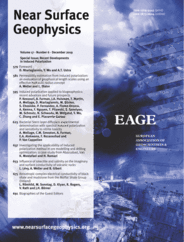
Full text loading...
 , A. Furman2, J.A. Huisman3, T. Martin4, A. Mellage5, D. Ntarlagiannis6, M. Bücker7, S. Ehosioke8, P. Fernandez9, A. Flores‐Orozco10, A. Kemna11, F. Nguyen8, T. Pilawski8, S. Saneiyan6, M. Schmutz12, N. Schwartz13, M. Weigand11, Y. Wu14, C. Zhang15, E. Placencia‐Gomez8
, A. Furman2, J.A. Huisman3, T. Martin4, A. Mellage5, D. Ntarlagiannis6, M. Bücker7, S. Ehosioke8, P. Fernandez9, A. Flores‐Orozco10, A. Kemna11, F. Nguyen8, T. Pilawski8, S. Saneiyan6, M. Schmutz12, N. Schwartz13, M. Weigand11, Y. Wu14, C. Zhang15, E. Placencia‐Gomez8
This paper provides an update on the fast‐evolving field of the induced polarization method applied to biogeophysics. It emphasizes recent advances in the understanding of the induced polarization signals stemming from biological materials and their activity, points out new developments and applications, and identifies existing knowledge gaps. The focus of this review is on the application of induced polarization to study living organisms: soil microorganisms and plants (both roots and stems). We first discuss observed links between the induced polarization signal and microbial cell structure, activity and biofilm formation. We provide an up‐to‐date conceptual model of the electrical behaviour of the microbial cells and biofilms under the influence of an external electrical field. We also review the latest biogeophysical studies, including work on hydrocarbon biodegradation, contaminant sequestration, soil strengthening and peatland characterization. We then elaborate on the induced polarization signature of the plant‐root zone, relying on a conceptual model for the generation of biogeophysical signals from a plant‐root cell. First laboratory experiments show that single roots and root system are highly polarizable. They also present encouraging results for imaging root systems embedded in a medium, and gaining information on the mass density distribution, the structure or the physiological characteristics of root systems. In addition, we highlight the application of induced polarization to characterize wood and tree structures through tomography of the stem. Finally, we discuss up‐ and down‐scaling between laboratory and field studies, as well as joint interpretation of induced polarization and other environmental data. We emphasize the need for intermediate‐scale studies and the benefits of using induced polarization as a time‐lapse monitoring method. We conclude with the promising integration of induced polarization in interdisciplinary mechanistic models to better understand and quantify subsurface biogeochemical processes.

Article metrics loading...

Full text loading...
References


Data & Media loading...

